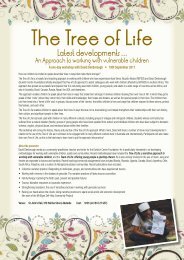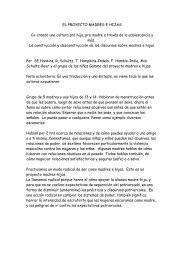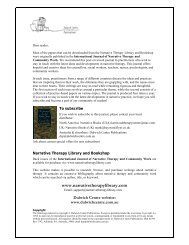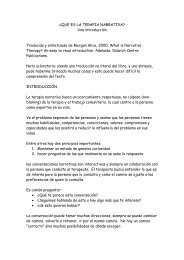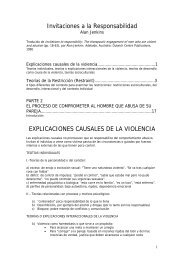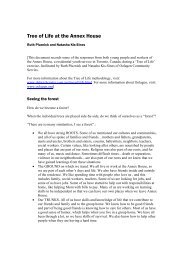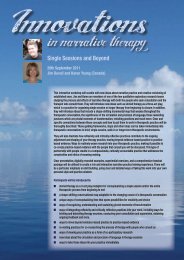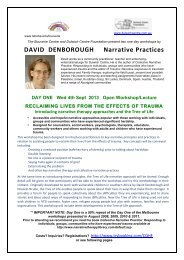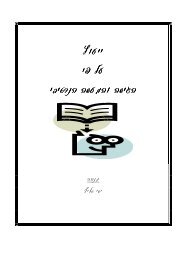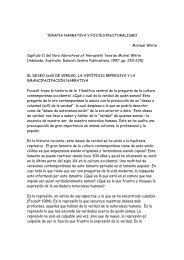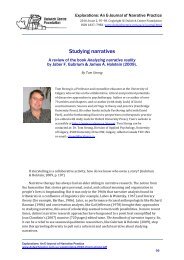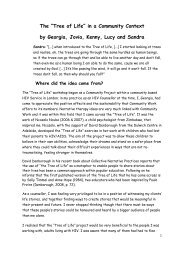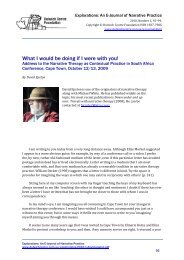Saying hullo again: Remembering Michael White - Dulwich Centre
Saying hullo again: Remembering Michael White - Dulwich Centre
Saying hullo again: Remembering Michael White - Dulwich Centre
Create successful ePaper yourself
Turn your PDF publications into a flip-book with our unique Google optimized e-Paper software.
Journal of Systemic Therapies, Vol. 27, No. 3, 2008, pp. 1–15<br />
SAYING HULLO AGAIN:<br />
REMEMBERING MICHAEL WHITE<br />
DAVID EPSTON<br />
<strong>Michael</strong> was a very humble and unassuming person. I am quite sure wherever he<br />
is now watching over these proceedings that he would be very discomfited by the<br />
outpourings of shock, grief, and mourning over his death on the one hand and the<br />
reverence in which he has been held and tributes paid to him from Quito in Ecuador,<br />
to Seoul in South Korea, from Moscow in Russia, to Capetown in the Republic<br />
of South Africa. <strong>Michael</strong>’s worst fear was of hagiographies—I remember when<br />
he told me how worried he was of such versions of his life; I had to go and look<br />
up “hagiography.” I learned it was the literary genre to do with the lives of the<br />
saints. In fact, I suspect that out of respect for <strong>Michael</strong>, many of us deferred to his<br />
wishes for anonymity and only spoke of such matters in private or at least far away<br />
from <strong>Michael</strong>’s hearing. I know I certainly was one of those but I expect there<br />
were many like me. He cringed in the face of what became a version of celebrity<br />
in the world of psychotherapy in which he came to be regarded as one of the most<br />
significant influences on his generation. I guesstimate the books he either coauthored<br />
or authored have sold well over 100,000 copies in 12 languages and once<br />
<strong>again</strong> I guesstimate well over 30 separate translations. Now that <strong>Michael</strong> is not<br />
here to censure us, I wanted to speak in the merest outlines of his life’s work and<br />
do so by way of celebration and honor. No one I know was readier to honor others<br />
than <strong>Michael</strong> and he made the term “honoring” a catch phrase. Let me give you<br />
one of a thousand possible stories from our friendship. <strong>Michael</strong> was an extraordinary<br />
cyclist. His fierce determination was matched by his physical capabilities.<br />
After all, in his early 50s, <strong>Michael</strong> entered his first full triathlon. <strong>Michael</strong> came<br />
out of the water first swimming <strong>again</strong>st 20-year-old semi-professionals. We would<br />
cycle up from sea level in Adelaide to the summit of Mt. Lofty—0 to 750 meters—<br />
taking over an hour and a half. Not surprisingly, I would finish some time after<br />
him and I mean some time. He would always be waiting, thrilled to see me as if<br />
I came in first. “Eppy” he would say, “you rode so well . . . slow and steady . . .<br />
This contribution was a speech that David Epston delivered at ‘<strong>Remembering</strong> <strong>Michael</strong>’ at The Family<br />
Therapy <strong>Centre</strong> in Auckland, New Zealand on May 23rd, 2008; it was also read aloud by Suzanne<br />
Pregerson/Rick Maisel in a ‘<strong>Remembering</strong> <strong>Michael</strong> <strong>White</strong>’ ceremony in San Rafael, California. The<br />
Editor would like to thank David Epston for so graciously allowing his expressions about his long<br />
time friend and colleague, <strong>Michael</strong> <strong>White</strong>, to be published in the Journal of Systemic Therapies.<br />
David can be contacted at bicycle2@xtra.co.nz<br />
1
2 Epston<br />
I have just got to learn to ride like you do!” A stranger may have found such<br />
comments feigned or even preposterous but if you knew <strong>Michael</strong> well, you knew<br />
that he really meant it. He really wanted to learn to ride like I did, even if it would<br />
have handicapped him considerably in any time trial.<br />
So tonight, I am going to speak without reference to <strong>Michael</strong>’s restraints on<br />
how he wished to stand to one side of his ingenuity and at times his wizardry. I<br />
remember too that when some colleagues and I at John F. Kennedy University—<br />
near Berkeley, California, where <strong>Michael</strong> and I both taught in the early to mid-<br />
90s—decided that his “body of published work” merited a doctorate and we, without<br />
informing him, proceeded to submit an application on his behalf. He did receive<br />
a Doctor of Human Letters (D.Litt.) in 1996. I was there that day and <strong>Michael</strong>,<br />
always expressing thanks to us, went through that day as if he had a sharp pebble<br />
in one or both of his sandals. To this day, I still am in two minds if we had done<br />
the right thing. I suspect <strong>Michael</strong> was just too kind to say anything to the contrary,<br />
given that we were acting on our good intentions.<br />
But to my way of thinking, <strong>Michael</strong> was an amateur philosopher. I don’t mean<br />
amateur in the sense of amateur as a poor version of a professional but rather the<br />
older dictionary meaning of amateur—one who cultivates a thing as a pastime. It<br />
was always extraordinary how such an “amateur” led the world of psychotherapy,<br />
etc. into what John McLeod calls the post psychological, which he referred to thus:<br />
“to a greater or lesser degree they define therapy as primarily a social process than<br />
a psychological one . . . that they are seeing a historical and cultural shift in relation<br />
to the meaning and practice of therapy.”<br />
I was taken by <strong>Michael</strong>’s sheer delight with those ideas that unsettled or troubled<br />
the taken for granted and allowed for ways to live and think otherwise than had<br />
been previously permissible or even conceivable given that such ideas had gained<br />
the status of a “truth.” First, he read the Iconoclast Gregory Bateson, but tired after<br />
a few years of translating that into his practice/thinking. But then he turned to<br />
Michel Foucault whose range of thought was vast beyond belief—who seemed<br />
able to turn just about everything upside down and if not upside down, at least to<br />
tilt that which had previously seemed so solid on to a precarious 90 degree angle.<br />
<strong>Michael</strong> caught the wave of postmodernism earlier than almost anyone else in the<br />
world of psychotherapy and the skillful surfer he was, he sailed to unknown seas<br />
on it, taking many of us along with him, such was the sheer pleasure he took in<br />
“deconstructing” the world around him. In other ways, his mind was like a posthole<br />
digger. His readings and re-readings of the middle Foucault—and each reading,<br />
<strong>Michael</strong> seemed to savour this more—were penetrating, always going deeper at<br />
the same time as the effects of his readings radiating out into his practice/teaching.<br />
What limited him was the time available for such a pursuit. This amateur cultivated<br />
his pastime late at night or on airplanes between teaching assignments<br />
around the world. I often wondered if <strong>Michael</strong> had far more time to cultivate such<br />
a pastime what that would have meant to Narrative Therapy. But for me, who was<br />
a fellow traveller, it was remarkable to watch, say, what <strong>Michael</strong> did over a de-
Memorial 3<br />
cade with Myerhoff’s paper which I first gave him a copy of in 1983; or the book<br />
chapter of Foucault’s, “Power and Knowledge,” which I copied off for him in 1985.<br />
To meet him later on for discussions or to teach together, it was fascinating to<br />
witness the inexorable expansion of these ideas over that vast divide of abstract<br />
theory to practice.<br />
I have always considered <strong>Michael</strong> to merge in himself the rare combination of<br />
practitionership and scholarship but always ensuring that his practice came ahead<br />
of his scholarship. I do not consider that theory made <strong>Michael</strong> but rather <strong>Michael</strong>’s<br />
own clinical ingenuity exploited theory—they were merely tools for him to think<br />
further than his inventions had led him so far. There was always this backwards<br />
and forwards between his practice and his tools to think with. This radiated throughout<br />
his most recent and last book—Maps of Narrative Practice (2007), in which<br />
he took it upon himself to commentate on his own life as a practitioner-scholar.<br />
His clear intention was one that reflected his own modesty—that is to make his<br />
practice and the ideas that inform them as easily accessible as possible for us to<br />
appraise and if we seek to do so, to apprentice ourselves to. In his humility, he<br />
often left out the genius and at times wizardry all those who had the opportunity<br />
to sit in on more than a few meetings or watched his videotapes have witnessed.<br />
Have you ever watched a videotape of <strong>Michael</strong>’s, mesmerized, like I have, and<br />
all of a sudden realized that the conversation had passed over some sort of bridge<br />
between despair and renewed hope and you wondered if you had lost consciousness<br />
for a split second because you hadn’t noticed that happening? Has the coin<br />
of the “explicit” heads been turned over to reveal the “implicit” tails so quickly<br />
that, like me, you swear it was some sort of magic? <strong>Michael</strong>, in every workshop<br />
he ever taught and every book he wrote, did his darnedest to bequeath to us—his<br />
readers/students/workshop attendees—his practice/scholarship. He was generous<br />
to a fault. He tried to give away everything he had to each and every one of us<br />
who was willing to watch, listen or read. That was what made his last book—Maps<br />
of Narrative Practice—so significant to me. He used his “maps” to reveal which<br />
way he was going and why he might head in that direction, at the same time warning<br />
us that there were so many directions he may very well have headed in—or that<br />
you might head in.<br />
<strong>Michael</strong> possessed a remarkable but gracious ease by which he could move<br />
between the large ideas of scholarship and the intimate and particular ideas of<br />
practice. Having known <strong>Michael</strong> for 27 years, I think few in our field can go from<br />
what seems to be one extreme to another without a lot of border stops in between.<br />
At each border stop, many others I know of get heavily taxed passing through<br />
each stop. By the time, say, the scholar reaches his/her practice they seemingly<br />
have been so depleted, it is often hard to see much connection between the two.<br />
At times, the theory seems like sheer window-dressing. <strong>Michael</strong>, with only a few<br />
speed bumps to slow him down, travelled from one domain to the other seemingly<br />
unimpeded. I have always found this breathtaking and a testament to the<br />
conjunction of a remarkable spirit merging with an equally remarkable scholar-
4 Epston<br />
ship. In his last book, Maps of Narrative Practice (2007), they were so woven<br />
together as to appear seamless. That is far from easy to achieve.<br />
Either reading one of his transcripts or watching a videotaped meeting—which<br />
<strong>Michael</strong> considered to be an ethical responsibility to continually make available,<br />
to expose his practice and the ideas that informed it to the widest critique—I want<br />
you to imagine how taxing this must have been for such a modest person. But<br />
<strong>Michael</strong> lived by a quote of Foucault’s: “we know what we do, we think we know<br />
what we think, but do we know what what we do does.” <strong>Michael</strong> authorized his<br />
clients and the communities that petitioned him to have the first judgement; his<br />
professional colleagues came second. Still, he was willing to allow us to go to the<br />
very heart of his practice and judge for ourselves. You could almost palpably feel<br />
the relish with which <strong>Michael</strong> met the people who consulted him and how they in<br />
turn savoured those meetings. It brought it home to me how enriching this work<br />
we do is to our lives—the “two-way street” that <strong>Michael</strong> unashamedly so often<br />
spoke about. <strong>Michael</strong> always assumed that we were the lucky ones and I know he<br />
certainly considered himself to have always been the lucky one in such meetings.<br />
In fact, I think <strong>Michael</strong> looked up to those he met.<br />
Let me read you a quote from the philosopher Phillip Caputo in a book chapter<br />
about Michel Foucault in which he guesses what kind of therapist Foucault might<br />
have been, given that he had no explicit therapeutic intentions whatsoever throughout<br />
his philosophical career, but remember his first degree was in psychology and<br />
he did an internship in a public psychiatric institution in the 1950s in France.<br />
He writes: “Such a therapy” (if Foucault invented one that is) “does not look at<br />
the mad as patients in the sense of objects of medical knowledge but as patiens—<br />
as ones who suffer greatly—who suffer from their knowledge. Such a patient would<br />
not be an object of knowledge but an author or subject of knowledge, one from<br />
whom we have something to learn.”<br />
Caputo went on to surmise that for Foucault as a therapist “the healing gesture<br />
meant to heal this suffering is not intended to explain it away or fill in the abyss<br />
but simply to affirm that they are not alone, that our common madness is a matter<br />
of degree, that we are all siblings in the ‘same night of truth.’ The healing gesture<br />
is not to explain madness if that means to explain it away but to recognize it as a<br />
common fate, to affirm our community and solidarity.”<br />
Compare this to my abstract of a quote from <strong>Michael</strong> in 1993 which was so<br />
telling about why he did what he has done.<br />
And what of solidarity? I am thinking of a solidarity that is constructed by therapists<br />
who refuse to draw a sharp distinction between their lives and the lives of others,<br />
who refuse to marginalize those persons who seek help, by therapists who are constantly<br />
confronting the fact that if faced with the circumstances such that provide the<br />
context of troubles of others, they just might not be doing nearly as well themselves.<br />
In 1981, I was asked to introduce <strong>Michael</strong> and his colleagues at a workshop on<br />
their work with people having psychotic experiences at the 2nd Australian Fam-
Memorial 5<br />
ily Therapy Conference in his home town of Adelaide. I recall sitting there stunned<br />
throughout. After all, several years before I had spent two years of a masters degree<br />
in the United Kingdom reading everything there was written at the time about<br />
family therapy. Luckily for me, there wasn’t that much to read in those days. I<br />
recall it dawning upon me that I was witnessing the “launching” of a new school<br />
of family therapy. I don’t quite know what possessed me but I insisted on standing<br />
up afterwards and formally announcing what seemed to me to be an ineluctable<br />
conclusion. That a new school of family therapy had been “born” and we<br />
had all witnessed that. In 1983, after teaching together at the 4th Australian Conference<br />
in Brisbane, <strong>Michael</strong>, Cheryl, and I had dinner together afterwards. I don’t<br />
recall how the conversation came up but <strong>Michael</strong> and I decided to become “brothers.”<br />
This was pre-AIDS so one of them suggested blood brotherhood. I had to<br />
beg off because I faint at the sight of anyone’s blood, especially my own. But we<br />
decided to make our ideas and practice common property and vowed that we would<br />
never become rivals. We did what we said we would do all these years right up<br />
until he died. In fact, we had made another vow late last year—one we can no<br />
longer keep—that we would meet a fortnight ago in Adelaide to sit down and plan<br />
our next project and book which undoubtedly would have kept us joyfully busy<br />
well into our respective dotages. I will always remember <strong>Michael</strong> as my brother<br />
and a remarkable man.<br />
With that in mind, I want to remind you of the luckiest breaks in the history of<br />
Narrative Therapy. In the late 1970s, <strong>Michael</strong> published a paper in the prestigious<br />
journal Family Process, reporting on his work with the problem of anorexia at<br />
the children’s hospital in Adelaide where he worked. The advisory editor (Chris<br />
Beels) informed me some years ago that it was the first paper ever published showing<br />
positive results with the problem of anorexia. Soon after that, the Deputy Director<br />
of Psychiatry obviously heard about this and forbade <strong>Michael</strong> from meeting<br />
with families in which there was a young person diagnosed with anorexia because<br />
he was a social worker and was unfit for the task which should be restricted to<br />
more august medical and psychiatric practitioners. <strong>Michael</strong> refused to adhere to<br />
this edict and continued to meet with these families and they with him. The next<br />
step the Deputy Director took was to remove all the chairs from <strong>Michael</strong>’s room.<br />
<strong>Michael</strong> and the families merely continued, now sitting on the floor. Then the<br />
Deputy Director imposed on <strong>Michael</strong> what I gather he assumed would drive him<br />
into some other form of employment, rather smartly, that from then on, he would<br />
be allowed only to meet with young people who had failed 2-year-long psychoanalytic<br />
treatments for the problem of encopresis or in common parlance, soiling.<br />
This was truly dirty work. Little did the Deputy Director know he had challenged<br />
<strong>Michael</strong> in the same way Foucault must have been challenged by what he had<br />
witnessed in a public psychiatric institution. Here <strong>Michael</strong> would be required to<br />
turn the tables on conventional psychiatric wisdom and in doing so invent externalizing<br />
conversations and in turn narrative therapy. I know <strong>Michael</strong> once told<br />
me he had a 99% success rate in an average of 4 meetings. So much so that he felt
6 Epston<br />
obliged, perhaps with his tongue in his literary cheek, to submit these results as<br />
having to do with pseudo-encopresis because if it was true encopresis, such claims<br />
to these results would have had to have been the ravings of a lunatic. <strong>Michael</strong><br />
turned the problem of soiling into the object of everyone’s scrutiny and called<br />
into question the very cultural construction of a problem, something so taken for<br />
granted that at first this was met with disbelief in some quarters, great relief in<br />
others. <strong>Michael</strong> allowed his work and their outcomes to form the critique of that<br />
which he so opposed—the turning of people into problems and by doing so, to<br />
degrade them, to look down on them and finally to dismiss them. In his work at<br />
Glenside, a state psychiatric hospital where he worked for many years part-time,<br />
his team weighed the files of the candidates for their service. If they weighed 2<br />
kilos or more, they welcomed them to their service. He would always add: “but<br />
we would never read them.”<br />
I believe what <strong>Michael</strong> most objected to and why he felt such a kinship with<br />
Foucault was the prevailing professional ways of seeing those who sought their<br />
help with the so-called gaze. The feminist scholar, Marilyn Frye, refers to this as<br />
the “arrogant eye,” a gaze that takes the professional’s own standpoint as central,<br />
their opinions, desires and projects as the salient ones, their experience and understanding<br />
as what is the case. The arrogant eye, she writes, allows them to absorb<br />
the identities of others into their own. From the point of view of the arrogant<br />
eye, insofar as patients exist, they exist for the professional. They are dismissed<br />
and degraded in the light of such an eye. Frye asserts that the loving eye knows<br />
the independence of the other. It is an eye of one who knows that to see the seen,<br />
one must consult something other than one’s own will and interests. Under the<br />
“loving eye,” people who lay claim to certain kinds of knowledges aren’t unauthorized<br />
or deligitimated because they are not regarded to be in a position to know.<br />
The loving eye confers social standing on those who have been dismissed and<br />
degraded by the arrogant eye. I have no doubt that <strong>Michael</strong> looked upon everyone<br />
with what Frye referred to as a loving eye. To fall under <strong>Michael</strong>’s loving<br />
gaze you felt the utmost in respectworthiness, which was in absolute contrast to<br />
the blameworthiness of so many of the psychological and psychiatric gazes.<br />
<strong>Michael</strong> had an intimitable voice and quaint vocabulary that bent the English language<br />
at times almost to its breaking point. He could be said to have willingly<br />
misused language to create new language. There are so many of his linguistic<br />
inventions that haven’t made the Oxford English dictionary yet but they will. My<br />
favorite is “knowledged.” I am sure many of us have adopted some of these <strong>White</strong>isms<br />
to refresh our own thinking perhaps even without knowing it. It is through<br />
his poetic vocabularies that you most easily appreciate both the novelty and subtlety<br />
of his thought and his intention to turn language inside out—to expose how underpoliticized<br />
language is.<br />
<strong>Michael</strong>’s loving eye had a tongue that constantly misused language without<br />
which according to the philosopher Feyerabend, “There can be no discovery.”<br />
<strong>Michael</strong> certainly had more than his fair share of discoveries. At times, the eccen-
Memorial 7<br />
tric ways he put these thoughts into words seemed so incandescent compared to<br />
how opaque many of his sources were. He illuminated ideas and the light that was<br />
reflected back allowed many of us to go where we might otherwise have found it<br />
hard going. To see how <strong>Michael</strong>’s mind, which was as unrelenting as rust, worked,<br />
I know I would watch for the slight shifts in his vocabulary which told me what I<br />
was seeking. <strong>Michael</strong> would often remonstrate with me when I would attend his<br />
workshops at conferences: “Why are you here? You know all this? You have heard<br />
it before!” I would reply: “Every time you say it differently and that is what I am<br />
interested in hearing—the slight shifts in your vocabulary.” But more generally,<br />
<strong>Michael</strong> illuminated and cleared a swath in the “fields” of social work, psychology,<br />
psychiatry, etc. for many of us to ply our avocations. If I have been told by<br />
hundreds that “if it wasn’t for Narrative Therapy, I would have had to leave my<br />
profession for some other kind of work,” <strong>Michael</strong> must have heard this so many<br />
more times than that.<br />
<strong>Michael</strong> was inspirational in this regard, but never appealing to sentimental<br />
sermonizing on the one hand or the polemical on the other. He inspired by his<br />
practice which was a counter-practice to that which he was critiquing and, as such,<br />
his critiques were always unassuming in their manner and implicit. They were<br />
never empty or uninformed. He demanded of himself that he should offer clear<br />
plans of what is to be done and how to do it.<br />
There is so much to say about and thank <strong>Michael</strong> for and this is a feeble<br />
attempt.<br />
I was teaching in Bogotá, Colombia when I received the news that <strong>Michael</strong> had<br />
perished. I persisted with this dedicating that teaching as a tribute to <strong>Michael</strong>. On<br />
the last of the four days, Mariana Saenz, waiting until everyone else had left, approached<br />
me and told me how desperately sad she was about <strong>Michael</strong>’s death and<br />
began to sob inconsolably, asking what could she do on his behalf. I advised her<br />
of the <strong>Dulwich</strong> <strong>Centre</strong> website that had been set up. She continued sobbing. I<br />
quietly asked her: “Did you meet <strong>Michael</strong> when he taught here in Bogotá six years<br />
ago?” “No,” she replied. “Have you read his books?” “No,” she replied <strong>again</strong>. I<br />
was running out of options here but went on to ask: “Did you or are you studying<br />
him in your training?” “No,” she replied. “How did you know him?” I finally asked.<br />
She replied: “Through your stories about him.” I had never thought of that as I<br />
had never considered I would be telling posthumous stories about <strong>Michael</strong>. But<br />
now I am and so can you. This will assist all of us to keep <strong>Michael</strong> well and truly<br />
alive in our lives and in our work in the same way he was so alive in his life and<br />
his work.<br />
I wanted to end this by a song. This song was written and sung by Margarita<br />
Boom from Cancún, Mexico. She did so at my request when Narrative Therapy<br />
was invited by the Cuban Psychiatric Association and Cuban Social Work Association<br />
to introduce Narrative Therapy to Cuba. We refused to comply unless<br />
they would in return introduce us to what they chose to refer to as “Cuban Social<br />
Programs.” This conference, sponsored by the World Psychiatric Association
8 Epston<br />
and the International Federation of Social Work, entitled: “The Spirit of Community:<br />
Narrative Therapy and Cuban Social Programs” was held in early January,<br />
2007 in Habana. Margarita’s song speaks to how we hoped to meet them<br />
and embodies for me the “spirit” of Narrative Therapy—that “loving eye” I<br />
referred to by which <strong>Michael</strong> looked to those he met throughout the course of<br />
his work and his life.<br />
HERMANO DEL SOL Y TIEMPO<br />
Deja que estreche tu historia<br />
y se llenen mis manos<br />
de nuevos sentidos,<br />
que nunca habia visto,<br />
quenunca habin sido,<br />
que no habri podido<br />
entender sin tu trino,<br />
que tienen tu nombre<br />
que traza un camino.<br />
Deja ue lleve conmigo<br />
un pedazo de tiemp<br />
compartido<br />
y el sabor a tibieza<br />
que deja el amigo.<br />
Hermno de sol y tiempo<br />
qhe imp[orta el color del viento!<br />
Nos une un sabor a sueno.<br />
A mano con mano<br />
Ir sosteniendo<br />
un pedazo,<br />
un cachito de mundo donde se pemita<br />
andar a tu paso,<br />
sentir lo que sientes,<br />
y aunque diferente,<br />
cantar con tu canto.<br />
Dej que tome tu conciencia<br />
y me lleve de vuelta<br />
la certeza<br />
que siendo distintos,<br />
somos parecidos
Memorial 9<br />
Que el corazon late<br />
los mismos latidos,<br />
pero que tu forma<br />
nventa<br />
otro ritmo<br />
Deja que aprenda tu musica<br />
y enriquezca mi mundo<br />
con tu mirada<br />
y tenga en tu alma<br />
una nueva morada.<br />
Hermano el so y tiempo<br />
que importa el color del viento!<br />
Nos une un sabor a sueno<br />
BROTHER OF THE SUN AND OF TIME<br />
Let me hold your story<br />
and fill my hands<br />
with new sensations<br />
that I’ve never seen before<br />
which have never existed<br />
which I couldn’t have understood<br />
without your song<br />
They bear your name<br />
and trace out a road.<br />
Let me take with me<br />
a piece of our<br />
time together<br />
and savour the warmth<br />
a friend leaves behind.<br />
Brother of the sun and of time<br />
who cares what colour the wind is?<br />
We are joined by the taste of a<br />
dream<br />
Of being hand in hand<br />
holding<br />
a small piece,<br />
a bit of a world
10 Epston<br />
where you are allowed<br />
to walk at your own pace<br />
to feel what you feel<br />
and, although different,<br />
to sing your own song.<br />
Let me take your conscience<br />
and leave taking with me<br />
the certainty<br />
that although we are different<br />
we’re alike<br />
That the heart beats<br />
to the same beat<br />
but your form<br />
creates a new rhythm<br />
Let me learn your music<br />
and enrich my world<br />
wth the look of your eyes<br />
and to find in your soul<br />
a new home.<br />
Brother of the sun and of time<br />
who cares what colour the wind is?<br />
We are joined by the taste of a<br />
dream.<br />
—Margarita Boom, Cancún, Mexico



